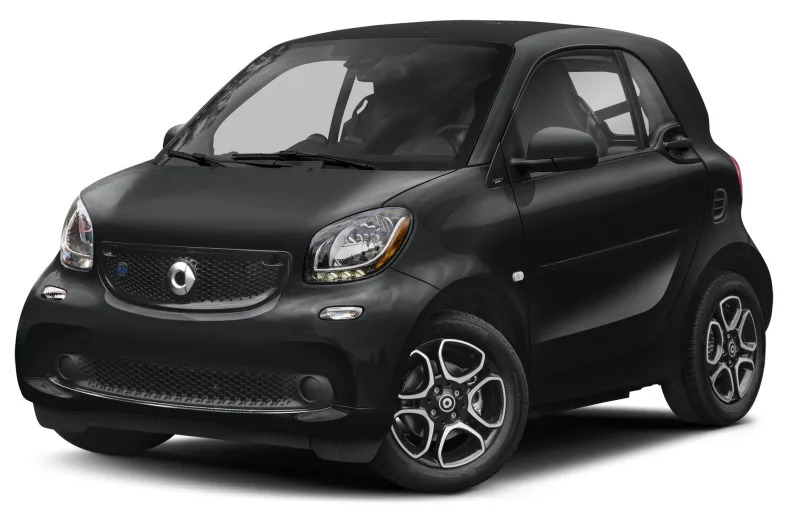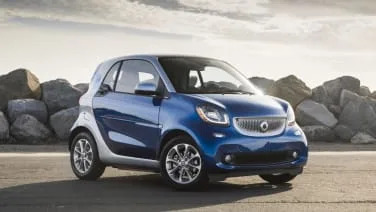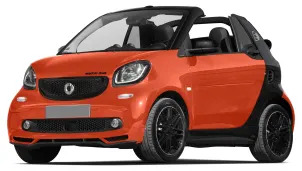2018 smart fortwo electric drive
I went into my weeklong loan of the Smart ForTwo Electric Drive expecting to dislike it. Seven days later, I didn't find anything that had changed my mind. But before I get into all the reasons you shouldn't buy an electric Smart, I think it's only fair that I offer up some positives. First, like all Smart ForTwo models, the ED is extremely maneuverable and has the best turning radius in the business. Second ... well, that 22.8-foot turning radius is really something special. For $24,650, the Smart ForTwo Electric Drive — I'll decline to make any jokes about the ED initials of early electric Smart models, but know that the humor is not lost on me — offers up a range of 58 miles on a full charge of its 17.6-kWh lithium-ion battery pack. We'll get back to that little specification shortly. What little forward thrust is available comes from a three-phase synchronous electric motor that produces 80 horsepower and 118 pound-feet of torque. 0-60 takes 11.4 agonizing seconds, and the top speed is mercifully limited to 81 miles per hour. My test car was equipped with a few options that pushed its price up to $29,810 and added an ironic "Passion" script just ahead of the side-view mirrors. We'll address the elephant in the room right now. For $30,875, the 2018 Nissan Leaf offers more range — in fact, at 151 miles, almost three times as much range — more power, more seats, more cargo room, and it's more fun to drive. For $37,495, the Chevy Bolt is better still, and its range of 238 miles on a full charge means it could be a legitimate primary vehicle for the vast majority of Americans. There are two seats in the Smart ForTwo Electric Drive. In front of the driver is a gauge binnacle that houses a speedometer along its outer edge, and an electronic display that can show things like current state of charge, available range, or an energy flow gauge that helps you keep tabs on how efficiently you're driving. Oddly, there's another gauge pod atop the left side of the dash with gauges that mechanically duplicate state of power and the percentage of power currently being consumed. The rest of the interior is made up of an assortment of plastics, some optionally colorful and others various shades of black, and none of it feels worthy of a $30,000 sticker price. In our last test of the Smart ForTwo Electric Drive, we called the interior finishings "a tragic universe of mismatched petrochemical schmutz." That just about sums it up. Some casual observers mentioned to me that they thought the Smart looked too small to be safe. I can't personally vouch for its ability to save you in a crash, but I can dismiss concerns that it feels unsafe out on the highway. It's predictably bouncy — a byproduct of its 73.7-inch wheelbase — but it feels reasonably planted on the road, even at highway speeds. So I'm …
Full Review
I went into my weeklong loan of the Smart ForTwo Electric Drive expecting to dislike it. Seven days later, I didn't find anything that had changed my mind. But before I get into all the reasons you shouldn't buy an electric Smart, I think it's only fair that I offer up some positives. First, like all Smart ForTwo models, the ED is extremely maneuverable and has the best turning radius in the business. Second ... well, that 22.8-foot turning radius is really something special. For $24,650, the Smart ForTwo Electric Drive — I'll decline to make any jokes about the ED initials of early electric Smart models, but know that the humor is not lost on me — offers up a range of 58 miles on a full charge of its 17.6-kWh lithium-ion battery pack. We'll get back to that little specification shortly. What little forward thrust is available comes from a three-phase synchronous electric motor that produces 80 horsepower and 118 pound-feet of torque. 0-60 takes 11.4 agonizing seconds, and the top speed is mercifully limited to 81 miles per hour. My test car was equipped with a few options that pushed its price up to $29,810 and added an ironic "Passion" script just ahead of the side-view mirrors. We'll address the elephant in the room right now. For $30,875, the 2018 Nissan Leaf offers more range — in fact, at 151 miles, almost three times as much range — more power, more seats, more cargo room, and it's more fun to drive. For $37,495, the Chevy Bolt is better still, and its range of 238 miles on a full charge means it could be a legitimate primary vehicle for the vast majority of Americans. There are two seats in the Smart ForTwo Electric Drive. In front of the driver is a gauge binnacle that houses a speedometer along its outer edge, and an electronic display that can show things like current state of charge, available range, or an energy flow gauge that helps you keep tabs on how efficiently you're driving. Oddly, there's another gauge pod atop the left side of the dash with gauges that mechanically duplicate state of power and the percentage of power currently being consumed. The rest of the interior is made up of an assortment of plastics, some optionally colorful and others various shades of black, and none of it feels worthy of a $30,000 sticker price. In our last test of the Smart ForTwo Electric Drive, we called the interior finishings "a tragic universe of mismatched petrochemical schmutz." That just about sums it up. Some casual observers mentioned to me that they thought the Smart looked too small to be safe. I can't personally vouch for its ability to save you in a crash, but I can dismiss concerns that it feels unsafe out on the highway. It's predictably bouncy — a byproduct of its 73.7-inch wheelbase — but it feels reasonably planted on the road, even at highway speeds. So I'm …
Hide Full Review
Hide Full Review
Retail Price
$23,800 - $29,100
MSRP / Window Sticker Price
| Engine | |
| MPG | Up to 124 city / 94 highway |
| Seating | 2 Passengers |
| Transmission | 1-spd auto |
| Power | 80 @ rpm |
| Drivetrain | rear-wheel |
| Curb Weight | 2,363 - 2,383 lbs |
Smart Buy Program is powered by 



![Daimler to sell half its stake in Smart to Geely, Reuters reports [UPDATE]](https://edgecast-img.yahoo.net/mysterio/api/3835453A45085BAB16D90E014667B386B243279472AF81FB690087164652E5A0/autoblog/resizefill_w376_h212;quality_85;format_webp;cc_31536000;/https://o.aolcdn.com/images/dims3/GLOB/crop/1822x1030+378+597/resize/376x212!/format/jpg/quality/85/https://s.yimg.com/os/creatr-uploaded-images/2019-03/b420dc90-4fdd-11e9-b7df-09e142d567c8)


